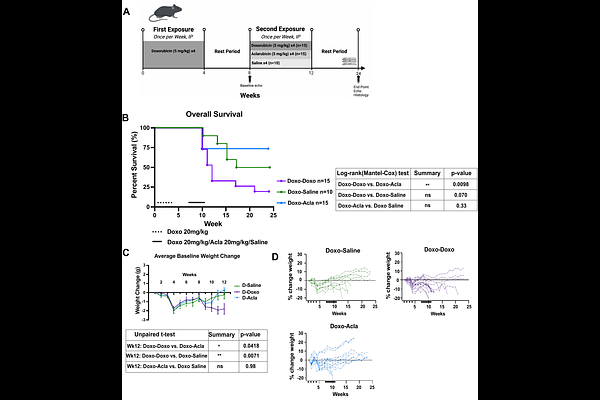Determining preclinical safety of Aclarubicin in pediatric malignancies

Determining preclinical safety of Aclarubicin in pediatric malignancies
Tu, D. S.; Olson, A. K.; Waggie, K. S.; Garcia, N. M.; Hoglund, V. J.; Walter, S.; Rosinski, J. R.; Sadeeshkumar, H.; Patel, R.; Sayar, E.; Haffner, M.; Maves, L.; Neefjes, J.; Sarthy, J. F.; Lawlor, E. R.; Ganapathi, S. S.
AbstractBackground: Anthracyclines are among the most effective chemotherapeutic agents used to treat pediatric malignancies. However, their clinical use is limited by dose-dependent toxicities, particularly cardiotoxicity and secondary malignancies. Aclarubicin (Acla) is an anthracycline derivative that induces chromatin damage while sparing DNA, offering potential therapeutic benefit with reduced long-term toxicity. Methods: We evaluated the anti-tumor efficacy and safety profile of Acla in multiple in vitro pediatric cancer models and in vivo mouse models designed to mimic anthracycline re-treatment following prior doxorubicin (Doxo) exposure. Tumor growth, genotoxic stress, survival, and organ toxicity were assessed. Results: Acla demonstrated robust anti-tumor activity comparable to Doxo across diverse pediatric in vitro models. Unlike Doxo, Acla treatment did not induce significant genotoxic stress. In vivo, mice receiving Acla after Doxo exposure showed no evidence of cumulative cardiotoxicity or end-organ damage. In contrast, a second course of Doxo led to significant toxic mortality, but was surprisingly not attributable to classic cardiac injury. Conclusion: Our study highlights Acla as a promising anthracycline derivative for pediatric cancers, with potent anti-tumor efficacy and a superior safety profile, even following prior anthracycline exposure. These results support continued investigation of chromatin-damaging anthracyclines that can kill pediatric cancer cells without inducing genotoxic stress. In addition, our studies underscore the need to refine preclinical models to better understand both acute and chronic anthracycline toxicities in pediatric and adolescent populations.